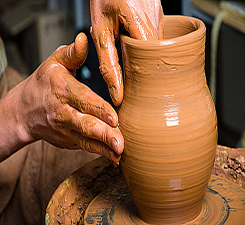|
||||||
|
 
 |
|
Check out the following articles and books on pottery and
alchemical vessels.
These are all Adobe "pdf" documents that you can save or print out. You can download the Adobe Reader from: http://get.adobe.com/reader/ |
The Potter as Alchemist
In many ways, the work of the
modern potter mirrors the work of the ancient alchemist.
Potters blend earthly materials like clay, stone, and
ash, into complicated glaze mixtures. Then through fire,
these base substances transform into precious works of
art. With glaze chemistry, and one part modern alchemy,
potters turn the natural elements we once took for
granted into the treasured artifacts we display in our
homes and galleries. It’s interesting to see how much the glazing,
alchemy, and human life relate to each other. Bernard
Leach, author of A Potter’s
Book, helps us understand glazes by relating them
to the body. He says most glazes have three main parts
-- the blood, bone, and flesh. Here is how they work:
1.) Fluxing agent
or “life blood of the glaze”
– causes the glaze
materials to melt and flow together in the kiln firing. 2.)
Refractory or “bone of the glaze” -
resists heat and melting, providing structure and
strength to the glaze body. 3.) Glass
Former or “flesh of the glaze” -
creates complexity, depth and unique qualities.
The early alchemists fused their chemical efforts with the body. Calling their experiments the Magnum Opus or “Great Work,” these men searched tirelessly for the right chemical concoctions that would enrich life or prevent death. In some ways, full-time potters do the same through glaze chemistry. They are constantly searching for that perfect potion that will immortalize a clay body and turn sand, water, and ash into gold.
The earliest record of pottery dates
back to the Late Paleolithic period in central and
western Europe, where fired and unfired clay figurines
were created as a form of artistic expression. As early
as 30,000 years ago, at a site known as Dolni Vestonice
in the Czech Republic, figurines made of clay mixed with
crushed mammoth bone were found.
Open firing techniques were used to
produce the earliest pottery. Through this method,
temperatures could range from 600-900 degrees Celsius,
which are relatively low temperatures. Firing pottery in
a kiln produces much hotter temperature. Enclosing the
pottery inside a chamber results in key advantages: the
temperatures that can be achieved are higher, last
longer, and the heat can be controlled more efficiently.
The simplest forms of kilns are pit kilns, which is a
pit fire installation where the fuel is placed at the
bottom, followed by the pottery, and more fuel in the
upper layer. Another type of kiln is an updraft kiln,
which is usually a cylindrical construction divided into
two compartments: the lower compartment is where the
fuel is placed, while the pottery is placed in the upper
compartment. This allows the heat to rise and the
pottery is fired at a temperature level normally ranging
from 1,000 to 1,200 degrees Celsius.
At these temperatures, the mineral
components of clay melt, resulting in a thin,
translucent, white vitrified type of ceramic that is
known as porcelain. By analysing the chemical
composition of pottery fragments, it is possible to
determine at what temperature the pottery was exposed,
and therefore we can understand the level of
technological sophistication of a society, at least in
terms of their firing capabilities.
|
| © 2014-2015. All rights reserved.AlchemyPottery.com. | Home | Our Services | Gallery | New Arrivals | Articles | Contact us |






